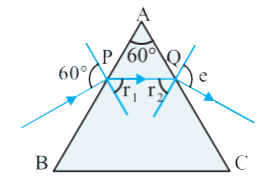A light ray incidents on an equilateral triangle with an angle of 30∘. Find the angle of deviation of the emergent light ray if the angle of emergence from the second surface is 70∘.
To solve the problem of finding the angle of deviation of the emergent light ray from an equilateral triangle prism, we can follow these steps:
1. Identify the Given Values:
- Angle of incidence (i1) = 30 degrees
- Angle of emergence (i2) = 70 degrees
- Angle of the prism (A) = 60 degrees (since it is an equilateral triangle)
2. Use the Formula for Angle of Deviation:
The formula relating the angles is:
i1+i2=A+d
where:
- d = angle of deviation
3. Rearrange the Formula to Solve for Deviation:
We can rearrange the formula to find the angle of deviation (d):
d=i1+i2−A
4. Substitute the Known Values:
Now, substitute the known values into the equation:
d=30+70−60
5. Calculate the Angle of Deviation:
Perform the calculation:
d=100−60=40 degrees
6. Conclusion:
The angle of deviation of the emergent light ray is 40 degrees.
Final Answer:
The angle of deviation of the emergent light ray is 40 degrees.
- Angle of incidence (i1) = 30 degrees
- Angle of emergence (i2) = 70 degrees
- Angle of the prism (A) = 60 degrees (since it is an equilateral triangle)
The formula relating the angles is:
i1+i2=A+d
where:
- d = angle of deviation
We can rearrange the formula to find the angle of deviation (d):
d=i1+i2−A
Now, substitute the known values into the equation:
d=30+70−60
Perform the calculation:
d=100−60=40 degrees
The angle of deviation of the emergent light ray is 40 degrees.
The angle of deviation of the emergent light ray is 40 degrees.
Topper's Solved these Questions
- LIGHTBOOK - PEARSON IIT JEE FOUNDATIONCHAPTER - LIGHTEXERCISE - Test Your Concepts (Very Short Answer Type Question)
29 Videos
- LIGHTBOOK - PEARSON IIT JEE FOUNDATIONCHAPTER - LIGHTEXERCISE - Test Your Concepts (Short Answer Type Question)
14 Videos
- KINEMATICS BOOK - PEARSON IIT JEE FOUNDATIONCHAPTER - KINEMATICS EXERCISE - CONCEPT APPLICATION (Level 3) (Application Based Questions )
5 Videos
- MAGNETISM BOOK - PEARSON IIT JEE FOUNDATIONCHAPTER - MAGNETISM EXERCISE - CONCEPT APPLICATION (Level 3)
4 Videos
Similar Questions
A ray of light falls on a material body at an incident angle of 30∘ and refracted at angle 60∘.
What is the measure of the angle of emergence 'e'?
View SolutionA ray of light falls on a glass prism at a angle of incidence of 30∘. Find the direction of the emergent ray if the angle of the prism is 60∘ and refractive index is 1.50
View Solution
Knowledge Check
The angle of incident of a light rays incidents on the surface of a plane mirror is 30∘ . The angle of deviation is
A120∘B30∘C60∘D90∘A ray incident a 15∘ on one refracting surface of a prism of angle 60∘ , suffers a deviation of 55∘ . What is the angle of emergence
A95∘B45∘C30∘DNone of these
A ray of light is incident on the glass prism at an angle of 40∘. Find the angle of emergence, if the angle of prism is 60∘ and refractive index is 1.5.
View SolutionA ray of light falls on a glass slab at an incident angle of 45∘ and refracted at angle of 30∘.
What is the measure of the angle of emergence 'e' ?
View SolutionA ray of light falls on one face of an equilateral prism at an angle of 40∘ and emerges out at an angole of 37∘ What is the angle of deviation through the prism ?
View SolutionA ray of light falls on a material body at an incident angle 60∘ and refracted at angle 30∘.
What is the measure of the angle of emergence 'e'?
View SolutionA ray of light is incident on a 60∘ glass prism at an angle of 60∘. Find the
the angle of emergence
the angle of deviation, given the refractive index of glass = 1.5.
View SolutionA ray of light is incident on one face of a prism (m=√3) at an angle of 60∘. The refracting angle of the prism is also 60∘. Find the angle of emergence .

View Solution
